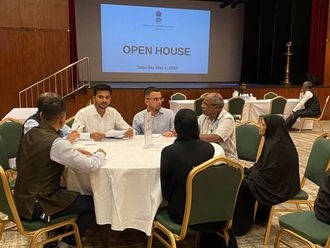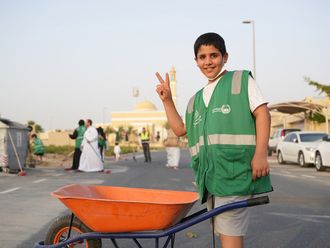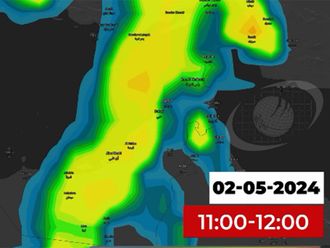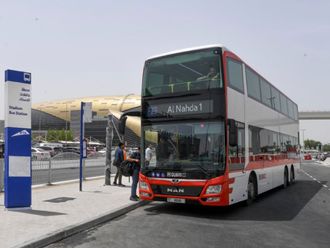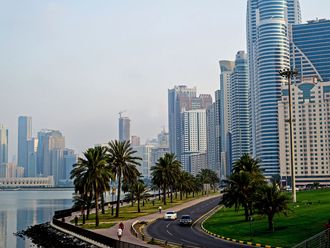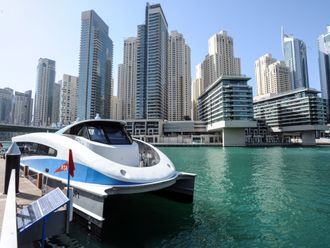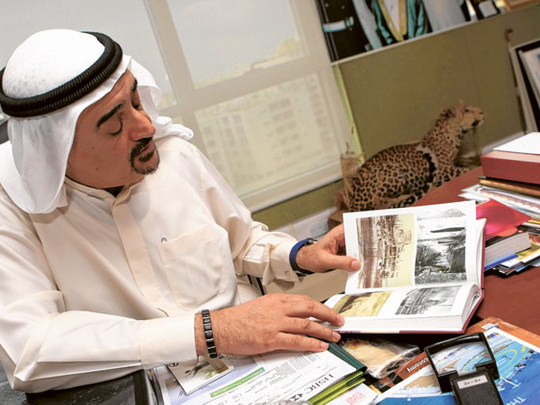
Fifty years after the MV Dara exploded and sank in the Arabian Gulf, retired Major General Sharaf Al Deen Sharaf still has high hopes that he may one day be re-united with his brother Ameen, from whom he was separated during the chaos of the accident.
Despite the tragedy, Sharaf, who is also the group vice-chairman of the Sharaf Group, was slowly able to overcome his fear of the sea and now faces it every day as his office has a view overlooking the calm waters of Port Rashid.
The explosion on the MV Dara took place on April 8, 1961, and now, five decades later, the vessel lies in 20 metres of water off the coast of Umm Al Quwain and has slowly turned into a home for marine life and a dive site for clubs in the UAE.
The MV Dara set off from Bombay [now Mumbai] on March 23, 1961, to make her way on a three-week voyage around the ports of Muscat, Dubai, Bahrain, Abadan and Basra.
The MV Dara then arrived back in Dubai on April 7 and, unfortunately, it was that fateful ship that his family chose to take for their vacation. Sharaf was just an 8-year-old boy at the time and was looking forward to the cruise that would take him to Karachi via Muscat.
"We took the ship because we were taking a family holiday in Karachi, which was one of the popular holiday destinations at the time. Many people used to go to India for their holidays, and to Shiraz, Mumbai, Zanzibar and Yemen."
Although Sharaf's father did not accompany him, the family members who went on the trip included his mother, his brothers Ashraf, 18, Ameen, 6, and 6-month-old Mohammad, along with his sister, 4, and their Emirati caretaker.
The MV Dara was unloading its cargo and disembarking passengers when a strong storm broke out, and it was decided by the captain to take the ship out of the harbour to ride out the storm.
"The ship was delayed and even though we had a room on the upper deck, we were shifted to the basement because of the heavy rain.
"We were all sleeping when I heard two loud explosions the next morning, sometime around 3am," Sharaf said.
A violent explosion occurred, causing a domino effect of fires that were fanned by the strong winds. The fires raced through three of the ship's decks, causing the vessel to sink within two days. The passengers started to jump off the ship in a bid to save themselves. Screams rent the air and bodies could be seen floating near the vessel. However, many were unable to escape unscathed.
"When I heard the first explosion, I woke up and went running upstairs to the upper deck. I then saw that the stairs were on fire, and I wasn't able to get to my mother and sister, who were down below. I didn't understand much about death and I didn't know why the people were floating."
As the passengers tried to find a safe escape from the ship, Sharaf was stuck in the middle of the crowd and was shoved from side to side.
"I saw my brother Ameen standing in front of me, but then people came in between and separated us. There was a lot of smoke and the engine was blowing up, and I could hear people saying that a bomb had gone off.
"Before I knew what was happening around me, I was taken away and put into a rowboat for almost two hours, until we met up with a motorboat that carried survivors. I was feeling very scared and lonely.
"I later found out that my baby brother was saved because the caretaker was able to put him in a bag and carry him to safety to Bahrain, where he was put in the care of a family until my father was able to bring him back to Dubai."
According to records, an inquiry was made in London into the explosion on the 5,000-tonne ship, which claimed the lives of 238 people.
The vessel was owned by the British India Steam Navigation Company.
Evidence of sabotage
A formal inquiry was conducted in London, which revealed that the explosion was the work of Omani rebels who had been driven out of the country by British troops in 1959.
During further investigations, Royal Navy divers discovered evidence on the wreckage of an explosion caused by 10 kilograms of explosives such as those typically used by the rebels in previous attacks.
The inquiry also revealed that most of the passengers and crew were Arabs and Indians, in addition to about a dozen British officers.
Once Sharaf was re-united with his father and elder brother, the search for his younger brother Ameen started.
On April 21, 1961, his father wrote a letter to the government hospital in Bahrain asking whether they had received a young boy by the name of Ameen Sharaf, but to his despair the hospital officials said they had never received anybody by that name or description.
As Sharaf sat in his office, he took out a book that documented the events of the MV Dara and contained pictures of survivors.
He pointed to one picture which showed a small boy sitting in a rowboat with dozens of survivors, which resembled his missing brother.
"Even though my elder brother doesn't think it could be him, I do."
After the accident, Sharaf's father prevented him from going to sea again. But he was unable to hold his son back for long, since Sharaf soon decided to join the Dubai Police, which provided him with an opportunity to sponsor his studies abroad at a police academy in Jordan.
"Before, the only options available to study were to either to go to Kuwait or Egypt. When the police announced that they were sponsoring people to go to Jordan, I took my chances and signed up. And it was in the police force where I finally learnt to swim."
Looking back on his narrow escape, he said he cannot help but think that God was watching over him.
The accident was also not the first time Sharaf had come close to death, since a few years before he had fallen off a rowboat and was underwater for several minutes before he was rescued.
Over the years, Sharaf's father never gave up hope in his search for his lost son and in the late 1970s he went as far as to launch a campaign in Bahrain.
However, the search was fruitless and even though the Sharaf family got a few leads, nobody could be certain that they had found Ameen.
Part of the campaign included contacting local media, such as the Arabic newspaper Akhbar Al Khaleej, which mentioned that the Sharaf family was looking for Ameen even though it was 19 years after the MV Dara tragedy.
Living in hope
The article explained that the family believed Ameen was still alive after they had received a call from a relative in Bahrain, saying that they met had a man in his twenties who looked like Sharaf's brother. Despite their attempts, they were unable to make contact with the man in question and ascertain his identity.
"We still hope my brother was able to make his way to Bahrain. He may have lost his memory and may be living under a different name.
"Before my father died, he said he had a feeling that my mother was still alive. People cannot help but live with hope. If you don't see the remains of the person it is difficult to think they have passed away.
"You need to see the remains of the person, and only then can you stop searching," Sharaf said.
In remembrance
In commemoration of the 50th anniversary of the bombing and sinking of the ‘MV Dara', the shipping company P&O launched an online exhibition on April 9, 2011. The virtual exhibition is hosted on P&O Heritage's website, www.poheritage.com, and is available in Arabic and English.
Visitors are provided with a detailed narration and rare photographs and footage of the tragedy that hit the ‘MV Dara' on April 8, 1961, during a routine voyage between India, Pakistan and the Gulf states. The tragedy of the ‘MV Dara' is considered the worst maritime disaster in Dubai's history, in which 238 lives were lost.
The exhibition also includes an In Memoriam of those recorded as lost in the disaster, a description of the ship and details about the day the disaster occurred. It also offers recollections by the passengers and crew about the explosion, the rescue operations and the sinking of the ship, in addition to the investigation and its findings. The formal inquiry into the incident led to extensive reforms to maritime passenger safety regulations over the following years.
Top 10 deadliest naval disasters
- MV Doña Paz: Death toll of approximately 4,375. The MV Doña Paz was a Philippine-registered passenger ferry that sank after colliding with the MT Vector on December 20, 1987. It was travelling from the island of Leyte to Manila.
- SS Kiangya: Death toll between 2,750 and 3,920. SS Kiangya was a Chinese passenger steamship which blew up, probably after hitting a mine which destroyed her stern, at the mouth of the Huangpu River 80 kilometres north of Shanghai on December 4, 1948.
- MV Le Joola: Death toll of at least 1,863. MV Le Joola was a Senegalese government-owned ferry that capsized off the coast of Gambia on September 26, 2002.
- Tek Sing: Death toll of 1,800. The Tek Sing was a large three-masted Chinese ocean-going junk which sank on February 6, 1822, in the Belvidere Shoals.
- SS Sultana: Death toll about 1,800. The vessel was a Mississippi River steamboat paddle-wheeler destroyed by an explosion on April 27, 1865.
- RMS Titanic: Death toll of 1,517. RMS Titanic was the largest passenger steamship in the world when she set off on her maiden voyage from Southampton, England, to New York City on April 10, 1912. Four days into the crossing, she struck an iceberg and sank the following morning.
- Toya Maru: Death toll of 1,153. The Toya Maru was a Japanese train ferry constructed by the Japanese National Railways which sank during a typhoon in the Tsugaru Strait between the islands of Hokkaido and Honshu on September 26, 1954.
- RMS Empress of Ireland: Death toll of 1,073. RMS Empress of Ireland was a Canadian ocean liner and while steaming on the St Lawrence River in fog the Empress was struck amid ships by the Norwegian coal freighter SS Storstad and sank on May 29, 1914.
- PS General Slocum: Death toll estimated at 1,021. The PS General Slocum was a paddle steamer. On June 15, 1904, the vessel caught fire and burnt to the waterline in New York's East River.
- MS Al Salam Boccaccio 98: Death toll 1,020. The vessel was an Egyptian passenger ferry that sank on February 3, 2006, in the Red Sea en route from Duba, Saudi Arabia, to Safaga in southern Egypt.
– Source: www.thetoptenlist.net


